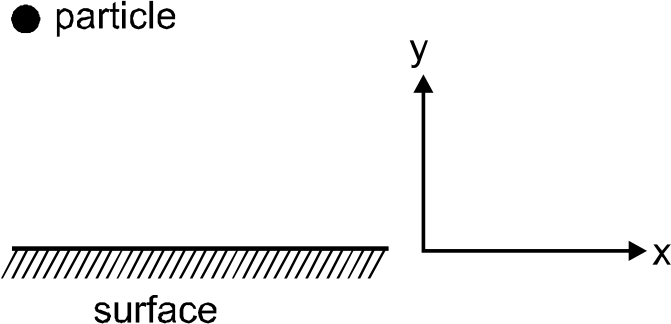A small sphere of mass m=1kg is moving with a velocity (4ˆi−ˆj)m/s. it hits a fixed smooth wall and rebounds with velocity (ˆi+3ˆj)m/s. The coefficient of restitution between the sphere and the wall is n/16. Find the value of n.
The correct Answer is:9
To solve the problem step by step, we will follow the concepts of momentum, the coefficient of restitution, and the components of velocity.
Step 1: Identify the initial and final velocities
The initial velocity of the sphere is given as:
Vi=4^i−^jm/s
The final velocity after rebounding is:
Vf=^i+3^jm/s
Step 2: Calculate the change in momentum
The change in momentum (ΔP) can be calculated as:
ΔP=mVf−mVi
Since m=1kg, we have:
ΔP=Vf−Vi=(^i+3^j)−(4^i−^j)
Calculating this gives:
ΔP=^i+3^j−4^i+^j=−3^i+4^j
Step 3: Calculate the velocity of separation (Vs)
The velocity of separation is the component of the final velocity in the direction of the wall. Assuming the wall is vertical, we consider the j component:
Vs=Component of Vf along ^j=3m/s
Step 4: Calculate the velocity of approach (Va)
The velocity of approach is the component of the initial velocity in the direction of the wall:
Va=Component of Vi along ^j=−1m/s
Step 5: Calculate the magnitudes of Vs and Va
The magnitudes are:
|Vs|=3m/s
|Va|=|−1|=1m/s
Step 6: Apply the coefficient of restitution formula
The coefficient of restitution e is defined as:
e=|Vs||Va|
Substituting the values:
e=31=3
Step 7: Relate the coefficient of restitution to n
We are given that:
e=n16
Setting the two expressions for e equal gives:
3=n16
Multiplying both sides by 16:
n=48
Final Answer
The value of n is:
48
The initial velocity of the sphere is given as:
Vi=4^i−^jm/s
The final velocity after rebounding is:
Vf=^i+3^jm/s
The change in momentum (ΔP) can be calculated as:
ΔP=mVf−mVi
Since m=1kg, we have:
ΔP=Vf−Vi=(^i+3^j)−(4^i−^j)
Calculating this gives:
ΔP=^i+3^j−4^i+^j=−3^i+4^j
The velocity of separation is the component of the final velocity in the direction of the wall. Assuming the wall is vertical, we consider the j component:
Vs=Component of Vf along ^j=3m/s
The velocity of approach is the component of the initial velocity in the direction of the wall:
Va=Component of Vi along ^j=−1m/s
The magnitudes are:
|Vs|=3m/s
|Va|=|−1|=1m/s
The coefficient of restitution e is defined as:
e=|Vs||Va|
Substituting the values:
e=31=3
We are given that:
e=n16
Setting the two expressions for e equal gives:
3=n16
Multiplying both sides by 16:
n=48
The value of n is:
48
Topper's Solved these Questions
- CENTRE OF MASSBook:CENGAGE PHYSICS ENGLISHChapter:CENTRE OF MASSExercise:Fill In The Blanks
Explore 2 Videos
- CENTRE OF MASSBook:CENGAGE PHYSICS ENGLISHChapter:CENTRE OF MASSExercise:SCQ_TYPE
Explore 12 Videos
- CENTRE OF MASSBook:CENGAGE PHYSICS ENGLISHChapter:CENTRE OF MASSExercise:Linked Comprehension
Explore 105 Videos
- CALORIMETRYBook:CENGAGE PHYSICS ENGLISHChapter:CALORIMETRYExercise:Solved Example
Explore 13 Videos
- DIMENSIONS & MEASUREMENTBook:CENGAGE PHYSICS ENGLISHChapter:DIMENSIONS & MEASUREMENTExercise:Integer
Explore 2 Videos
Similar Questions
A small sphere of mass 1kg is moving with a velocity (6ˆi+ˆj)m/s . It hits a fixed smooth wall and rebounds with velocity (4ˆi+ˆj)m/s. The coefficient of restitution between the sphere and the wall is
View SolutionA small sphere of mass 1 kg is moving with a velocity (6ˆi+ˆj)ms−1. It hits a fixed smooth wall and rebound with velocity (4ˆi+ˆj)ms−1. The coefficient of restitution between the sphere and the wall is
View SolutionA smooth sphere of mass m is moving on a horizontal plane with a velocity 3ˆi+ˆj when it collides with a vertical wall which is parallel to the ˆj vector. If the coefficient of restitution between the sphere and the wall is 1/2. find
a. the velocity of the sphere after impact,
b. the loss in kinetic energy caused by the impact.
c. the impulse that acts on the sphere.
View SolutionA particle of mass 'm' moving with a velocity of (4ˆi−ˆj)m/s strikes a fixed wall and finally moves with a velocity of (3ˆi+2ˆj)m/s. Find
(a) the impulse received by the particle.
(b) the coefficient of restitution between them in the collision.
View SolutionA smooth sphere is moving on a horizontal surface with velocity vector 2ˆi+2ˆj immediately before it hits a vertical wall. The wall is parallel to ˆj and the coefficient of restitution of the sphere and the wall is e=12. Find the velocity of the sphere after it hits the wall?
View SolutionA particle moving with velocity (2ˆi−3ˆj) m/s collides with a surface at rest in xz–plane as shown in figure and moves with velocity (2ˆi+2ˆj) m/s after collision. Then coefficient of restitution is :

View SolutionA particle of mass m moving with a velocity (3ˆi+2ˆj)ms−1 collides with another body of mass M and finally moves with velocity (−2ˆi+ˆj)ms−1. Then during the collision
View SolutionA smooth sphere of mass m is moving on a horizontal plane with a velocity (3ˆi+ˆj) . It collides with smooth a vertical wall which is parallel to the vector ˆj . If coefficient of restitution e=12 then impulse that acts on the sphere is
View SolutionA sphere is moving with velocity vector 2ˆi+2ˆj immediately before it hits a vertical wall. The wall is parallel to ˆj and the coefficient of restitution of the sphere and the wall is e=12. Find the velocity of the sphere after it hits the wall?
View SolutionA sphere is moving with velocity vector 2ˆi+2ˆj immediately before it hits a vertical wall. The wall is parallel to ˆj and the coefficient of restitution of the sphere and the wall is e=12. Find the velocity of the sphere after it hits the wall?
View Solution
